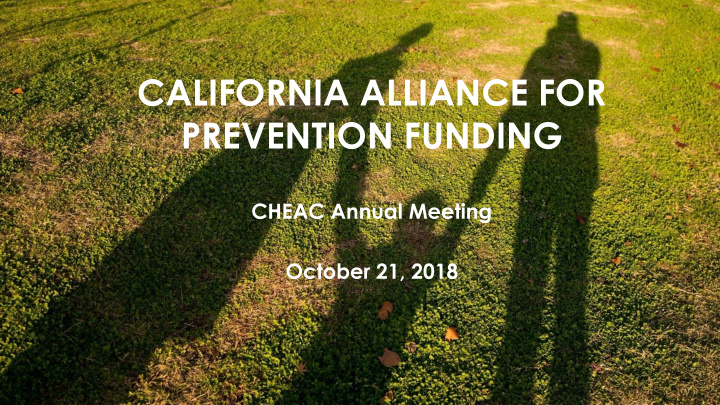



CALIFORNIA ALLIANCE FOR PREVENTION FUNDING CHEAC Annual Meeting October 21, 2018
THE CHALLENGE ➢ Creating a sustainable flow of funding to support prevention of noncommunicable disease and injury in California ➢ 2010: ACA and the Creation of the Prevention and Public Health Fund followed by threats to ACA and raids on the Fund
ELEMENTS OF A CALIFORNIA WELLNESS TRUST PROPOSAL Funding Source Governance Structure Operational Principles Allocation Criteria
REVENUE SOURCES – TOP CANDIDATES ➢ Soda tax ➢ Alcohol tax
How much would a soda tax raise in California? ) ➢ 1 ¢ per oz. raises approximately $1.2 billion per annum ➢ 2 ¢ per oz. raises approximately $1.7-2 billion per annum ➢ More if diet drinks covered (minus required funding to schools Prop 98 40%)
CA has very low taxes on alcohol compared to other states Type Ranking Price/gallon - Wine 49 th $.20 Spirits 34 th $3.30-$6.60 Beer 31 st $.20
Revenue that could be generated from increased sales tax on all alcohol (before education funding) Percent Tax Revenue generated 1% $280 mil 2% $560 mil 3% $850 mil
Revenue that could be generated from increased excise tax on alcohol Type Excise Tax Revenue generated Beer, 12 oz 25 cents $1.7 bil 10 cents $718 mil (possibly >6,000 barrels only) Wine, 5 oz 25 cents $828 mil 10 cents $357 mil Spirits, 1.5 oz 25 cents $1.14 bil 10 cents $494 mil
PROPOSED GOVERNANCE STRUCTURE ➢ State wide commission with spending authority ➢ Members appointed by state elected officials. Will include, but not be limited to: the state health officer, LHDs, a representative of residents who experience health inequities, and community-based equity and primary prevention advocates and experts. ➢ Small administrative entity to manage the work
Operational Principles ➢ Support the establishment of a statewide mechanism to assure long term, sustainable funding of local and state initiatives to promote health equity and prevent the leading causes of illness, injury, and premature death in California. ➢ Funding should support policies, systems environmental changes and community programs that work outside of health care settings to make California's communities more conducive to health.
Operational Principles (cont.) ➢ Funds should be distributed and coordinated among: local health departments; community-based, regional and statewide nonprofit organizations; and state government according to established criteria. ➢ Funds must benefit all Californians and promote greater equity and health, reaching residents from urban to rural areas, young and old, and across California’s diverse races and ethnicities.
Operational Principles (cont.) Moneys in the fund shall be used to address social, environmental, economic and behavioral determinants of chronic disease and injury at any phase of the life cycle, and to close gaps in health outcomes and inequities, including, but not limited to strategies that: Promote healthy diets, improved access to healthy foods, and • healthy food environments Promote physical activity and a safe, physical activity promoting • environment Prevent unintentional and intentional injury • Prevent harmful use of substances including tobacco, alcohol, and • drugs Address the social determinants of chronic disease • Support evidence- based or evidence- informed • practices that are include community priorities and experience.
ALLOCATIONS Entity Allocation Strategy & oversight % funds Notes Fixed floor of $250K. The remainder of funds available to local health departments will be divided among the jurisdictions according to two 45% LHD or designee New work plan must be submitted every three years. Work plan equally-weighted criteria: the number of people residing in the with optional can be based on recent community health assessments. In jurisdiction according to the California Department of Finance, and the subcontracts to counties where there is more than one grantee, must staff an CBOs. number of people residing in the jurisdiction who live in a household existing, or form a new, coalition to coordinate local efforts. earning 100% or less of federal poverty level according to the US Census. Prioritize geographic diversity. Competitive grants Local, community- 30% All local organizations that are awarded funding must participate based nonprofits in their county’s coalition. Regional and Statewide nonprofits Competitive grants 10% Media, campaigns, HiAP, statewide policy initiatives and other Range 5-10% chronic disease prevention work consistent with the SWT CDPH purpose. Secretariat of Commission. Lead planning and management of 5-10% SWT, including distributing funds, selecting competitive grants, Legal Entity Range managing contracts, coordinating evaluation and other Managing the Fund administrative duties. Foster alignment of work across grantees in geographic areas. Unused funding for each type of entity goes back to that type. Additional notes
Potential Roles for LHDs ➢ Support Regional Convenings ➢ Be champions for the idea ➢ Engage your local representatives, BOS, and other potential stakeholders and supporters ➢ Contribute technical expertise to help answer key questions ➢ Other?
Recommend
More recommend